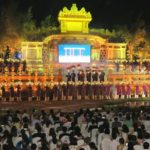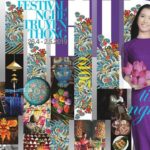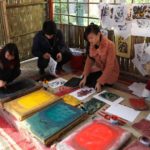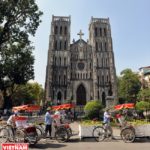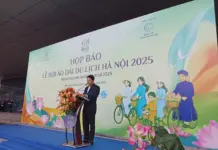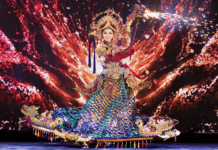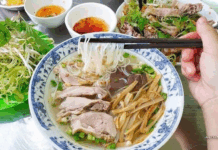Hanoi, the capital of Vietnam, is home to a plethora of cultural and historical sites that serve as invaluable assets for tourism development.
As a hallowed land of gifted individuals, Hanoi boasts a rich tapestry of heritage, encompassing 5,922 relics, 1,793 intangible heritages, and 1,350 craft villages, all complemented by picturesque natural landscapes.
| Ba Duong Noi Kite Flying Festival in Dan Phuong District, Hanoi. Photo: Mai Anh |
Cultural tourism is the hallmark of Hanoi’s tourism industry, with experiential tourism emerging as a key focus. This approach emphasizes tours to Hanoi’s heritage sites and handicraft villages.
Enhancing the Value of Tourism Products
Quoc Oai District, situated in the western outskirts of Hanoi, possesses unique cultural heritage and values. Its picturesque landscapes, auspicious feng shui, and rich history have endowed it with 101 listed relics, including the Thay Pagoda and the So Communal House, both designated as special national relics. Quoc Oai is also home to an array of intangible cultural heritage treasures, such as water puppetry, Do singing, Ham Rong Vi singing, Tuong singing, Cheo singing, Gong performances of the Muong people, and 55 traditional festivals. Quoc Oai’s proximity to central Hanoi, just a 30-minute drive, attracts a significant number of visitors annually.
According to Hoang Nguyen Ung, Vice-Chairman of the Quoc Oai District People’s Committee, the district has implemented the “Preserving and Utilising Traditional Cultural Identity and Values in Tourism Development in the District” project. This initiative aims to leverage available resources, foster tourism development, and safeguard traditional cultural values.
| A visitor to Duong Lam Ancient Village, Son Tay Town, Hanoi. Photo: Cap Thu Ha |
Long renowned as the ‘Land of Two Kings’, Duong Lam Ancient Village houses the Phung Hung and Ngo Quyen temples, honoring the national heroes who valiantly repelled invaders in the 8th and 10th centuries. This ‘living’ museum preserves the essence of a traditional northern Vietnamese village, complete with a gate, banyan trees, a wharf, a common house yard, and 956 time-honored houses. Each year, the village attracts approximately 150,000 tourists, including 6,000-7,000 international visitors.
Beyond admiring the architecture and scenic beauty of Duong Lam, visitors can immerse themselves in the local way of life through farming, cooking, and living alongside the villagers. These authentic experiences leave a lasting impression, particularly on foreign visitors.
Meanwhile, a visit to Bat Trang Ceramics Village offers the opportunity to mold clay and craft unique souvenirs. At the Temple of Literature – Imperial Academy and Thang Long Imperial Citadel, visitors not only explore historical sites but also participate in cultural activities and games that decipher heritage values. The Dao Thuc Water Puppetry Guild (Dong Anh District) engages visitors by showcasing performances, allowing them to interact with the artists and learn the art of puppetry.
| The vibrant Quang Phu Cau incense-making village. Photo: Trang Coco |
As Hanoi Travel Association Chairman Phung Quang Thang observes, the diversity of Hanoi’s heritage and craft villages presents a valuable opportunity to develop tourism products unique to each locality, catering to a wide spectrum of domestic and international tourists. This approach not only enhances the local economy but also enriches the knowledge and spiritual life of the community.
Enhancing the Tourist Experience
Hanoi is experiencing a surge in tourist arrivals, particularly international visitors. This positive trend has prompted the city’s tourism sector to seek innovative ways to attract and retain visitors. A priority is the development of new tourism products that showcase Hanoi’s distinct characteristics.
Hanoi has introduced various tourism products, including a pilot program of community-based tourism that combines authentic experiences in craft villages and tourist attractions with traditional cultural values of ethnic minorities in Ba Vi District.
In February, the Hanoi Tourism Department launched experiential tourism products linked to heritage sites, relics, and craft villages along the routes of Hanoi Center – Thanh Tri – Thuong Tin – Phu Xuyen, Hanoi Center – Thanh Oai – Ung Hoa – My Duc, and Hanoi Center – Son Tay – Ba Vi.
| The Bat Trang Ceramic Museum. Photo: Bich Hoi |
The department is currently developing a community-based tourism model that connects hands-on experiences in craft villages and tourist destinations with traditional cultural values of ethnic minorities in districts such as My Duc and Chuong My.
Experts emphasize the importance of a coordinated approach to make these products attractive and unique. It is essential to thoroughly understand the needs and desires of visitors to each locality and to tailor experiential products accordingly. For instance, while the experience at the Quang Phu Cau incense-making village currently revolves around check-in photography, there is a range of other potential activities that cater to visitors’ interests.
According to Phung Quang Thang, Hanoi should diversify tourist experiences by designing unique tours that explore history or provide immersive cultural encounters. These tours could involve experiencing the production stages of traditional handicrafts and cuisines. Interactions with locals, artisans, and renowned figures in the villages, as well as participation in traditional crafts and festivals, would further enrich the visitor experience.
In terms of developing tourist routes, it is advisable to create a diverse range of services and enhance the overall experience. Strengthening tourism promotion and establishing partnerships between localities for transportation of visitors to heritage and artisan villages are also crucial.
The success of this tourism product will not only attract visitors but also unlock the immense value of Hanoi’s cultural heritage.





